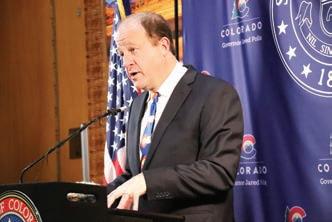
10 minute read
STRESSES
FROM PAGE 1 go to landlords. Young families can’t nd starter homes they can a ord. Retirees don’t see any attractive options for moving and downsizing, meaning their homes stay o the market, helping keep prices high.
“Just look west,” Polis said in his address. “In California, decades of poor planning has led to interruptions of drinking water and electricity for entire towns and cities, average home prices over $1 million in major cities and 16-lane freeways” with “bumper-tobumper tra c.” e governor then pivoted to what he sees as solutions. Since 2019, he said, billions of espoused by Jared Polis, the Democratic governor who last month surprised us with his intense focus on housing during his annual State of the State Address. Colorado “will soon face a spiraling point of no return” if housing remains on the course that it is now, Polis said.


Senior Reporter Ellis Arnold rushed to the Capitol for Polis’ news conference after the speech, getting a few o -thecu answers. Billions of dollars have already been spent in recent years to make housing more a ordable, the governor says. He highlighted federal American Rescue Plan Act funds, the stimulus that came during the COVID-19 pandemic. Also, Colorado voters in November decided to earmark hundreds of millions of dollars a year through Proposition 123, which backs local housing affordability e orts.
Yet, for all the tax dollars involved, the governor says, “We can’t just buy our way out of this.” Local rules, like zoning, need to be addressed too, he said.
Experts have told our reporters the same. Reporter McKenna Harford looks at how changes to zoning, among other strategies, can make housing more a ordable. Meanwhile, reporter Luke Zarzecki looks at how the development of our dollars have been invested in housing. For instance, American Rescue Plan Act funds have gone toward projects around the state, he said. And Colorado voters in November passed Proposition 123, which is expected to bring hundreds of millions more dollars to affordable housing e orts in the years ahead. at idea resonates with experts like Christy Rogers, who teaches housing policy at the University of Colorado Boulder.
“But we can’t just buy our way out of this,” Polis added.
Public o cials, he said, need to break down rules that stand in the way of building more housing.
“Where are our starter homes?” Rogers said. “Where’s our ability to provide housing cities contributes to healthharming pollution and how ideas like better-planned transit can improve our air and reduce climate change. Reporters Belen Ward and Steve Smith look at tiny homes and how di cult it can be to nd a home, even with some help. for a bunch of di erent income levels?” e governor appears to be headed in a direction where that kind of market is more possible. He said he wants to
In the end, there is no one solution and, frankly, the problem looks like it will continue, and potentially worsen, in the months ahead. Yet we acknowledge e orts to reverse the trend, including collaborations between federal, state and local o cials on myriad projects in our communities. We also hope that they are successful and that Colorado does not turn into what Polis decries — his portrayal of California as a poorly-planned nightmare, where residents face shortages in drinking water, commute on clogged highways and pay $1 million for a typical home.
In the months ahead, we plan to follow up with o cials and hold them accountable for their promises to improve the situation. We will ask for speci cs and then seek out local leaders and residents for their reactions. We also plan forums where our readers and local leaders can join us to speak about the work that needs to be done. In the meantime, we welcome your letters with ideas.

Many communities need more variety. Some need more density, housing units built closer together, she said.
Housing advocates often point to “the middle,” homes that are neither large, singlefamily units nor big apartment complexes. e middle consists of smaller single-family units and condos that get people their rst foothold in homeownership, a home that they can build equity in and, as their family grows, sell and reinvest the pro ts to upgrade to a bigger one.
Contributors to the project include:
“legalize more housing choices for every Coloradan” while “protecting the character” of the state.
Yet it is an idea marked mostly by the sweeping language of the governor’s speech — at least for now. Colorado Community Media asked the governor for more details since his address. In one statement, the governor said only that “across our state we need more housing for purchase and for rent at a lower price, and I look forward to working on all ways we can help make this happen.”
In another sign, the governor touted Lakewood’s “forward-looking vision” after he visited an apartment complex that includes some belowmarket-rate units and sits next to an RTD rail line.
Big spending
Another hint at what the governor wants came in response to questions after his State of the State Address. Polis said that he doesn’t want the state to get mired in age-old local debates over what the ideal mix is between a ordable and market-rate housing.
“ ere is no state AMI gure that works for Summit County, for Denver (and) for Boulder,” Polis said, in a reference to area median income, a measure often used to determine who is eligible for housing assistance.
However the mix of new homes might look, Colorado is wading deeper into spending to boost the supply of less costly housing.
Just days before the governor’s speech, the state announced a new program expected to help create up to 5,000 “high-quality, lowcost” housing units over the next ve years. e Innovative Housing Incentive Program directs funding to Colorado-based housing manufacturers in an e ort to boost the supply of houses that aren’t built traditionally. at includes modular homes, or factory-made houses, that are assembled at the location where the homeowner will move in.
Polis touted a company from the mountain town of Buena Vista, saying it “can build a home in roughly 18 working days, compared to close to a year for traditionally built homes.”
Alone, 5,000 new homes over several years won’t make a huge dent, but the state is also armed with other new initiatives.
Proposition 123 requires state ofcials to set money aside for more a ordable housing and related programs. e money could go toward grants and loans to local governments and nonpro ts to acquire land for a ordable housing developments.
Funds could also go to help develop multifamily rentals, including apartments, and programs that help rst-time homebuyers, among other e orts. As Proposition 123 ramps up, eventually about $300 million a year will be spent around the state on such e orts.
Polis’ o ce also highlighted how millions of dollars in federal economic recovery funds were spent amid the response to the coronavirus pandemic. In the last year, the state invested roughly $830 million into housing, including roughly $400 million based on funds from the federal American Rescue Plan Act in programs passed by state lawmakers, including:

• A ordable-housing spending detailed in House Bill 22-1304, which provides grants to local governments and nonpro ts toward investments in a ordable housing and housingrelated matters.
• A loan program under Senate Bill 22-159 to make investments in a ordable housing.
• e loan and grant program under Senate Bill 22-160 to provide assistance and nancing to mobile home owners seeking to organize and purchase their mobile home parks.
• e expansion of the “middle income access program” of the Colorado Housing and Finance Authority under Senate Bill 22-146. e authority, a state entity, invests in a ordable housing.
• e “Infrastructure and Strong Communities” program, also under House Bill 22-1304, to provide grants to enable local governments to invest in infrastructure projects that support a ordable housing. ose investments build upon an additional $460 million in emergency rental assistance, $180 million in homeowner assistance and $7 million in vouchers that Colorado also invested using federal funds, the governor’s o ce told CCM.
Polis portrayed housing as integral to the fabric of Colorado, placing it in the larger context of climate, economic and water policy.
“Building smart, e cient housing statewide, especially in urban communities and job centers, won’t just reduce costs, it will save energy, conserve our water, and protect the lands and wildlife that are so important to our Colorado way of life,” Polis said.
Beyond spending, zoning is an important tool that o cials — from the governor to city leaders — are looking at tweaking in hopes of alleviating the rising cost of housing and its e ects on communities.
State role in the mix
It’s a conversation that is older than many Coloradans. Making the case for new policies today, Polis harked back to changes from ve decades ago.
“ e last time Colorado made major land-use changes was in 1974 — before I, and most of you, were born,” Polis said. “We were a di erent state then.” e governor’s o ce didn’t specify to CCM more about those changes, but at least two pieces of legislation arose that year that a ected how local governments regulate how land is used.
Polis seemed to tease at the possibility of state intervention in how local communities govern housing. e governor and his o ce also didn’t specify what changes to zoning policy he would support or oppose. Polis has not said that he wants the state to require zoning changes in cities. Instead, the governor spoke about the state leaning in on an existing policy. e landscape of local governments’ power to a ect housing a ordability in Colorado saw a big change recently. In 2021, Polis signed state House Bill 21-1117, allowing cities to impose a ordable housing requirements on new or redeveloped projects, so long as developers or property owners have alternatives.
“Since issues like transportation, water, energy, and more inherently cross jurisdictional boundaries, it becomes a statewide problem that truly impacts all of us,” Polis said.
He spoke of the need for more exible zoning to allow more housing and “streamlined regulations that cut through red tape.” He touched on expedited approval processes for projects like modular housing, sustainable development and more building in transit-oriented communities.
“We want to lean in to allowing local governments to use tools like inclusionary zoning to help create the right mix for their community, and I think that local input in design is very important,” Polis said in a Jan. 17 news conference, following his address.
So-called “inclusionary” housing policies typically ask property developers to set aside a percentage of units in new developments for a ordable housing, although developers are given di erent options to ful ll those requirements, e Colorado Sun has reported.
For example, they could trade those for a ordable units built elsewhere, pay a fee into an a ordable housing fund, or any number of other options, the Sun reported.
It’s unclear whether Polis would support anything further than the existing allowance for cities to use inclusionary zoning.
As of late January, the governor was focused on gathering input to work with state lawmakers and develop a proposal on land-use policy. As of press deadline, no bill had been introduced.
‘Can’t expect to lose money’
Polis noted the wide gap that has opened between housing prices and people’s income over the last several decades, putting homeownership out of reach for many families.
More government spending on housing is part of the solution to a ordability, experts told CCM, including Yonah Freemark, senior research associate at the nonpro t Urban Institute, based in Washington, D.C.
“Assuming that we can rely entirely on the private market to address the a ordable housing need is, I think, unrealistic and unlikely to address the needs of the people who have the lowest incomes,” Freemark said.
Ron roupe, associate professor of real estate at the Daniels College of Business at the University of Denver, said “it’s inevitable” that government must provide the needed funding to bolster the supply side of the housing market.
“We do things (on) the supply side, but it’s not enough,” roupe said.
“And you can’t expect a developer to build something and lose money.”

Spending from higher levels of government could bene t in particular the suburbs, which are struggling with housing a ordability but have less political appetite to tackle the problem themselves, Freemark said.
“Ultimately, the most exclusionary places, which are often suburbs, have no incentive to invest in a ordable housing” because “they don’t see a ordable housing as (needed) by their residents,” Freemark said. at said, creating housing a ordability for key workers like teachers, police and re ghters is an important part of the puzzle for communities, roupe said.
“You lose your teachers, and then you lose the quality of your schools, and it hurts the area. Same with police and re,” roupe said.
In the larger business community, housing plays a crucial role too, Polis said.
“Coloradans have to be able to a ord to live in our communities where they can earn a good living, and companies need to be able to nd the workers they need to thrive,” he said in the speech.
‘We are not California’ e governor’s one-liner when speaking about housing — “We are not California. We are Colorado” — raises the question of where the state could be headed if it doesn’t change course.
Net migration, the di erence between the number of people coming into and the number of people leaving an area, has long been positive in Colorado. In 2015, net migration was about 69,000 people, according to the State Demography O ce. Although the number reached a recent pre-pandemic low in 2019 with about 34,000, newcomers are still owing in.
“ ere are (home) buyers moving in from out of state, and many of them come from higher-priced areas, so they don’t have sticker shocks,” roupe said, speaking to the sustained high demand and high prices in metro Denver.
Looking to the future, roupe doesn’t think the metro Denver housing market is on a similar trajectory that large metro areas such as New York City and San Francisco have experienced in terms of high housing prices.
“New York is a coastal city and anancial center — same with (several) California (cities), San Francisco. We’ll never be that. We’re our own animal,” roupe said.
“ e choice between those cities and Denver pricing-wise has been extreme; it’ll tighten up. It’ll never be their prices, but it’ll tighten up,” roupe added.
Freemark noted that geographically, Denver has less of a physical barrier to new construction than in places like San Francisco — and that New York City is largely surrounded by water.
Rogers, the teaching assistant professor in the program for environmental design at CU Boulder, described the metro Denver housing market’s future in terms of uncertainty.
“I think that we are in a place we’ve never been before, so I can’t extrapolate the future from that,” Rogers said. “I feel like we’re in unknown waters.”








